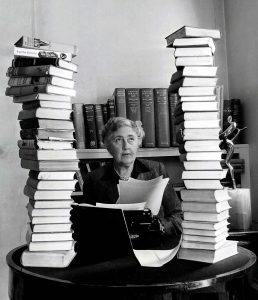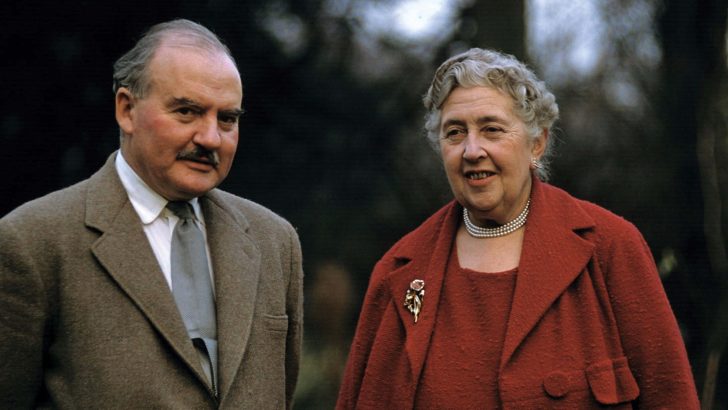Agatha Christie: A Very Elusive Woman by Lucy Worsley (Hodder & Stoughton, €23.99/£25.00)
Dr Lucy Worsley has become very much a fixture on our small screens, with a distinct penchant for dressing up in period costumes, which to some leaves an impression of history as mere fancy dress with a modern accent, rather than the deep well of pain and suffering it all too often was.
She has been involved in a long series of television documentaries, which have proved very popular, as well as a stream of associated books.
A thread in her recent work on screen and in print has been about British murders of the past. So it was perhaps inevitable that she should be asked to write a biography of Agatha Christie, the most widely read detective story writer of all time. However, due to a lack of fresh materials on Agatha Christie, or Lady Mallowan, as she might be better called, the creator of Poirot and Miss Marple is a difficult subject.
Again inevitably, Worsley devotes much attention to the notorious “missing 11 days” of the writer’s life in 1926, when she simply disappeared from her home and nearly two weeks later was found in a hotel in Harrogate.
Breakdown
Worsley sees this, as do many other writers, as a case of a psychological breakdown. However, the difficulties she had in her marriage belong very much to the traumas left over from the Great War working themselves out in the social turmoil of the 1920s. She was then only in her mid 30s and had published her first novel only in 1920.

Emerging from the event she had a new publisher and brought out The Murder of Roger Ackroyd, truly an astonishing landmark in detective fiction, as all her readers will know. This book was a major best-seller, over here and in America. She never looked back again as a writer, a new “Christie for Christmas” became a regular feature of the publishing year.
She had become in a sense a new person. And that person was a woman of varied achievement, which all the attention to what happened in 1926 detracts from. She became during the Great War years a qualified pharmacist and expert on poisons, which stood her in good stead later. She became, too, a truly professional writer in varied genres.
Her new publisher elevated her to “the Queen of Crime”, purely a marketing device. But a French expert on crime fiction more appropriately called her la Duchesse de la mort, the Duchess of death, which seems a far more appropriate title. But she was not so much elusive, as Worsley suggests, as intensely private, a deeply damaged victim of modern celebrity culture, who became wary of any kind of publicity or press intrusion. The public has no right to expect anything but new books from those who write.
But after 1930, when she married Max Mallowan, some 16 years her junior, she became an accomplished archaeological worker on her husband’s expeditions to the Middle East as a photographic artist and a specialist in the reconstruction of the shattered pots of ancient cultures that play such an important part in the modern system of archaeological dating. She has Poirot comment in several novels on the similarity of outlook, or should it be insight, of the detective and the archaeologist.
But what her biographers rarely allude to, and which would indeed enlarge our ideas about her moral universe, is her religion. She was a believing Anglican and Christianity inspired much of her overall outlook without obtruding too greatly into her books. But her faith provided her with a moral horizon that affected her views on life, death, and justice.
Golden Age
This was not in the era of her best work such a rare thing. A stream of Christianity runs through Golden Age detective literature. We should not forget GK Chesterton, Freeman Wills Croft, Dorothy L. Sayers, PD James and others.
Religion is an element in Agatha Christie’s work that most of those who write about her shy away from, perhaps from a fear of upsetting the readers of recent decades who love murder, mayhem, and Nordic noir, but don’t care much for religion. But I suspect her quiet undemonstrative faith may be a way into her mind and soul which biographers should not neglect. Though Poirot is supposedly a Belgian Catholic, his imagination like his creator’s is permeated by the words and images of the King James Bible as well as English nursery rhymes.
I also think that anyone who wants to approach and understand “the real Agatha Christie” should be sure to read Agatha Christie and Archaeology, a magnificent book by Charlotte Trumpler and others (British Museum Press, €15.99) which explores the dimensions of her work, life and writing in the Middle East with her second husband.
Achievement
Sir Max’s last great achievement was the excavation of the ancient city of Nimrud in Upper Mesopotamia (now in modern Iraq), which he published in two large books as a boxed set through Collins, his wife’s publishers, to which he was able to give a more elaborate presentation to than is usual for books of this kind. One suspects the royalties of his wife rightly subsidised this monument to his career.
Alas news now comes that the terrorists of Islamic State are destroying the remnants of this great city from “the age of ignorance”, as they refer to pre-Islamic times. They have stripped out such mobile pieces of art as can be shipped off through the international black market to Paris, London and New York to fund the continuing operations of IS. Thus do rich art collectors subsidise crime.
It would have broken the hearts of the redoubtable couple who worked so hard to reveal the ancient city of Old Testament times to the modern world. Age of ignorance indeed.


 Peter Costello
Peter Costello Sir Max (left) and Lady
Mallowan in later years.
Sir Max (left) and Lady
Mallowan in later years. 